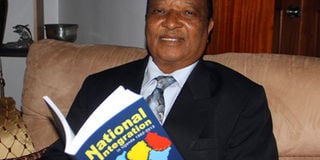Examining Uganda’s integration

Apolo Robin Nsibambi holds his book. PHOTOs by Ismail Kezaala.
What you need to know:
National integration. In his book National Integration in Uganda 1962-2013, Apolo Robin Nsibambi shows how the different regions have been integrated into Uganda as a nation.
Having served as prime minister of Uganda for 12 years, Prof Apolo Nsibambi is eminently qualified to write the book on national integration of Buganda, Karamoja, and the northern region into Uganda. The northern rehabilitation programmes and the Karamoja projects, were coordinated by the prime minister’s office. The author is also a renowned political scientist.
National Integration in Uganda 1962-2013 is divided into seven chapters: Chapter One covers the introduction; Chapter Two defines national integration; Chapter Three discusses the process of integrating Buganda into Uganda; Chapter Four covers integrating Karamoja into Uganda; Chapter Five focuses on integrating the Northern Region into Uganda; Chapter Six discusses the language factor and national integration in Uganda and Chapter Seven covers the conclusion.
Integrating Buganda
The book shows how post independence leaders attempted to integrate Buganda into the Uganda nation. Right through the governments of Milton Obote and Idi Amin, the author shows how the question of Buganda and its position has ofetn been addressed. For instance, the author identifies four major actions the Museveni regime has carried out to integrate Buganda into Uganda:
• restored the cherished monarchy,
• returned some of the properties that Obote had confiscated,
• addressed Buganda’s demand for federalism by proposing a regional government,
• attempted to address rampant and illegal evictions by putting in place the Land (Amendment) Act 2010.
Integrating Karamoja
The book shows that both colonial and post independence governments failed to integrate Karamoja into Uganda. It is the NRM government, under the leadership of Museveni, that succeeded in integrating Karamoja into Uganda.
However, it was not an easy process because Karamoja enjoys a remote location in the north east of Uganda; the Karimojong were not settled in a specific location as they moved their cattle from place to place in search of grass and they practised armed cattle rustling. It is during the Museveni government and NRM that grand projects have been implemented in Karamoja, with the major aim of developing and integrating the region into Uganda. At the centre of this was the Minister for Karamoja and Special Karamoja programmes, Ms Janet Museveni.
President Museveni launched a disarmament programme and Janet Museveni launched the Karamoja food security plan to reduce cattle rustling. Large water drawers have been constructed in each district and major bridges are being reconstructed. The leaders of Karamoja must own these projects in order to make them sustainable.
Integrating the Northern region into Uganda entails addressing the following issues:
First, there must be a removal of the economic gap between the north and the rest of the Country. This gap was worsened by the terrorist actions of Lord’s Resistance Army led by Joseph Kony, which shattered the North.
Second, President Museveni destroyed the historical monopoly of the army by Northerners, a monopoly which enabled the leaders from the North to capture state power and retain it. Northerners demand that they be equally represented in the army.
Third, the Northerners feel marginalised in the allocation of resources such as cabinet posts and Public Service.
Fourth, the Political Leaders have refused to replace customary tenure into freehold tenure, which investors prefer.
The language factor
The absence of a widely understood language in Uganda has meant that those ethnic groups which cannot communicate with each other continue harbouring prejudices and entrenching stereotypes which they hold against each other. Political leaders depend on interpreters when they are either campaigning or marketing government policies. Sometimes, interpreters distort critical complex messages from the leaders.
The author stresses that it was not possible to upgrade any of the indigenous languages to an official status because of the historical and ethnic rivalries. And so the language of the former colonial power (Britain) became a neutral official language. English is not widely understood in Uganda and it is the language of the educated people, therefore, it increases the social gap between the elite and the masses.
Kiswahili and English, which are official languages are not widely understood in Uganda. Uganda has failed to adopt a deliberate policy of marketing Kiswahili to become a national language. A deliberate policy includes hiring teachers to teach Kiswahili from Senior One to Senior Six.
Conclusion
The book shows that the Government has established Central authority over the Kingdom of Buganda, the Northern region and Karamoja. However, Government has failed to take deliberate steps to make Kiswahili and English, Uganda’s two official languages, widely understood. Consequently Government has failed to enhance trans-ethnic integration.
It is pointed out that the leaders of the Northern region must work together and allow market forces to govern the land market. This includes accepting customary land to become freehold land.
It is observed that when the Kingdom of Buganda disallows elected leaders, it is not accountable to the people of Buganda. Implementation of an elected regional Government by the Central Government will mean that there are two governments in Buganda, a problem which will confuse the ordinary Baganda.
Book title: National Integration in Uganda 1962-2013
Author: Apolo Robin Nsibambi




